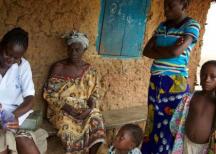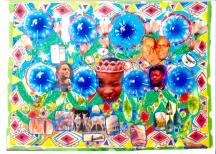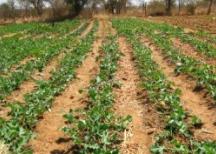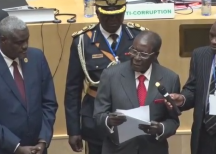HIV/AIDS poses an enormous challenge to gender equality in Africa, states Elize Delport. She writes that The Protocol to the African Charter on Human and Peoples’ Rights on the Rights of Women in Africa has the potential to ensure the development of a strategic human rights response specifically suited to those most affected by the pandemic – the women of sub-Saharan Africa.
Introduction
The HIV/AIDS pandemic arguably poses the greatest threat to the promotion and attainment of gender equality in Africa. It has the power and potential to nullify each and every human right and to erode any development gains. Conversely, the AIDS virus can only flourish when socio-economic rights like the right to adequate health care and proper nutrition are violated. It is only if the rights to equality and non-discrimination are violated, that the virus can take advantage of the social, political and economic vulnerability this creates to flourish unabated among women. Far from being merely a health issue, the pandemic is now recognised as a human rights and development crisis. Gender inequality is at the root of this crisis.
The statistics are alarming and clearly expose gender fault lines:
In sub-Saharan Africa, approximately 23 million adults aged 15-49 are living with HIV/AIDS. Of these 57 % (13.1 million), are women. This region is burdened with the highest HIV prevalence rates and displays the most disproportionate impact of the pandemic on women and girls. In 1985, roughly half a million women and half a million men were living with HIV/AIDS in sub-Saharan Africa. However, the number of women living with HIV/AIDS relative to men has increased every year. Particularly affected are young women aged 15-24, who are currently more than three times more likely to be infected than young men.
The impact of HIV/AIDS on women and girls
Gender roles and relations have a significant influence on the course and impact of the HIV/ AIDS pandemic. It is acknowledged that HIV/AIDS poses a greater threat to the lives and futures of women and girls. Gender inequality and power imbalances between women and men in every society heightens the vulnerability of women to infection and leaves them with heavier burdens when HIV/AIDS enters households and communities.
Research shows that being a female or male influences how a person experiences and responds to the HIV/AIDS epidemic.
Gender influences include:
? Individual risk and vulnerability to HIV infection:
? The experience of living with HIV/AIDS;
? The impact of an individuals HIV-related illness and death within a family or community; and
? Responses to the pandemic at the individual, community and national level.
Understanding the influence of gender relations on the ability of individuals and communities to protect themselves from HIV and effectively cope with the impact of AIDS, is crucial for expanding the response to the epidemic.
The centrality of gender inequality to the pandemic
The United Nations General Assembly Special Session on HIV/AIDS (UNGASS) convened in June 2001 marked a critical turn in the awareness of the international community around the centrality of gender inequality and discrimination to the pandemic. On this occasion, delegates from 180 countries acknowledged that gender equality and the empowerment of women are fundamental elements in reducing the vulnerability of women and girls to HIV/AIDS.
In the Declaration adopted at the UNGASS, States committed themselves to a wide range of actions to combat the HIV/AIDS pandemic, many of which address its gender dimensions. States are called upon to review the social and economic impact of HIV/AIDS at all levels of society, especially on women and the elderly, particularly in their role as caregivers, and in families affected by HIV/AIDS and address their special needs. States committed themselves to intensify efforts to challenge gender stereotypes and attitudes, and gender inequality in relation to HIV/AIDS, encouraging the active involvement of men and boys. Furthermore, the Declaration calls for national strategies to promote women’s full enjoyment of their human rights and for the elimination of discrimination against women. However, the question the Declaration leaves open is what women’s human rights actually are in the context of the pandemic.
In an innovative publication entitled ‘Turning the tide – CEDAW and the gender dimensions of the HIV/AIDS pandemic’, UNIFEM explains how, as a blueprint for women’s human rights, CEDAW is a critical tool for assisting us to understand what gender equality and the elimination of discrimination will require. In many of the critical areas for addressing HIV/AIDS from a gendered perspective - whether it is access to health services, care and care-giving, women’s leadership and participation or the ability to negotiate safer sex - CEDAW provides the guiding human rights principles and directives for action which, if realised, can turn the tide of the HIV/AIDS pandemic.
The Protocol to the African Charter on Human and Peoples’ Rights on the Rights of Women in Africa has the potential to build on the framework that CEDAW provides and to ensure the development of a strategic human rights response specifically suited to those most affected by the pandemic – the women of sub-Saharan Africa.
The Protocol to the African Charter on Human and Peoples’ Rights on the Rights of Women in Africa
Explicit reference to HIV/ AIDS in the Protocol is limited to Article 14, which deals with health and reproductive rights. This article provides that:
“1. States Parties shall ensure that the right to health of women, including sexual and reproductive health is respected and promoted. This includes:
d) The right to self - protection and to be protected against sexually transmitted infections, including HIV/AIDS;
e) The right to be informed on one’s health status and on the health status of one’s partner, particularly if affected with sexually transmitted infections, including HIV/AIDS, in accordance with internationally recognized standards and best practices…”
The implementation of these provisions is likely to be fraught with practical and ethical difficulties. Given the vast body of research that points to the gender and human rights dimensions of the HIV/AIDS pandemic, it is rather unfortunate and disappointing that the Protocol seemingly reverts to the out-dated approach of classifying the pandemic merely as a health issue.
While issues of gender and HIV/AIDS are not explicitly mainstreamed in the text of the Protocol, all is not lost provided we make every effort to ensure that issues of gender and HIV/AIDS form an integral part of our implementation strategies. Many articles in the Protocol provide appropriate responses to, and protection against, the ravages of the pandemic.
Mainstreaming issues of gender and HIV/AIDS in our implementation strategies
As a starting point, aspects of the pandemic for which the Protocol has special relevance should be identified. The key responses that are required in terms of the Protocol should then be set out. In addition, reference should be made to the guiding articles of CEDAW and relevant General Recommendations formulated by the CEDAW Committee.
This exercise should provide tools to support efforts to integrate a rights-based approach into programmes, policies and strategies to respond to the gender dimensions of the pandemic.
Building on the strategy suggested by UNIFEM in ‘Turning the tide – CEDAW and the gender dimensions of the HIV/AIDS pandemic’, the following may serve to illustrate this approach:
Gender inequality and safer sex
The challenges
Power imbalances and inequalities between men and women render many women unable to negotiate safer sexual practices with their partners. Such imbalance and inequality may stem from family structures, economic relations, differences in education and experience, exposure to violence and cultural expectations. In unequal relationships, women demanding safer sex may risk impoverishment or assault. Social norms dictate that women should be passive and compliant in sexual relations. The right to decide how and when sex takes place is regarded as a male prerogative. There are numerous constraints on a woman’s ability to engage only in sexual relations and practices that she chooses or desires. The autonomy needed by a woman in order to negotiate safer sex, depends on the realisation of her right to equality in many different areas of life.
The provisions of the Protocol, if effectively implemented and enforced, provide protection and guidance in the following ways:
Inequality within the family
Power imbalances within family relations often stem from forced marriages, male ownership and control over family resources and legal impediments to women obtaining divorce.
Article 6 of the Protocol obliges States Parties to ensure that women and men enjoy equal rights and are regarded as equal parties in marriage. In this regard, appropriate national legislation must be enacted to ensure, amongst other things, that:
? Marriage will not take place without the free and full consent of both parties;
? The husband and wife must, by mutual consent, choose their matrimonial regime and place of residence; and
? During her marriage, a woman will have the right to acquire her own property and to administer and manage it freely.
Article 7 of the Protocol obliges States Parties to enact appropriate legislation to ensure that women and men enjoy the same rights in cases of separation, divorce or annulment of marriage. Such legislation must provide men and women with the same rights to seek separation, divorce or annulment of a marriage and with the right to an equitable sharing of the joint property deriving from the marriage.
Early marriage of girls
Early marriage is regarded as a major factor in increasing women’s vulnerability to HIV. Marriage to an older man creates significant imbalances between husband and wife in terms of experience, authority and economic autonomy. The situation is exacerbated when a girl leaves school in order to marry and/or falls pregnant at an early age. Early marriage poses a serious threat to the health, education and employment prospects of girls.
Article 6 of the Protocol obliges States Parties to enact and enforce legislation to set the minimum age of marriage for women at 18 years. The further requirement that no marriage takes place without the free and full consent of both parties, has the potential to protect against forced marriages. The requirement that every marriage should be recorded in writing and registered in accordance with national laws in order to be recognized, may provide additional protection against early and forced marriage.
Early marriage may be seen as a harmful practice which negatively affects the human rights of women and which are contrary to international standards. In this case, Article 5 of the Protocol obliges States Parties to take all necessary legislative and other measures to eliminate such practices, including the creation of public awareness in all sectors of society regarding harmful practices through information, formal and informal education and outreach programmes.
Early marriage often goes hand in hand with violence against women. Article 4 of the Protocol obliges States Parties to take appropriate and effective measures to enact and enforce laws to prohibit all forms of violence against women in public or private, including unwanted or forced sex. States Parties are also obliged, through curricula and social communication, to eradicate elements in traditional and cultural beliefs, practices and stereotypes that legitimise and exacerbate the persistence and tolerance of violence against women.
Other initiatives and best practices
When exploring ways to include issues of HIV/AIDS in a Protocol implementation strategy, one may consider current initiatives and research that provide useful guidelines and recommendations in this regard. As time is not on our side, it makes sense to utilize existing information rather than to reinvent the wheel. Examples of current initiatives and research are:
The UN Task Force on Women, Girls and HIV/AIDS in Southern Africa
The Task Force on Women, Girls and HIV/AIDS in Southern Africa was convened by the United Nations Secretary General in 2003. This Task Force identified key actions to reduce prevalence rates among girls and women. These actions include:
? Protecting female school enrolment figures;
? Protecting girls and women from the direct and long-term risk of HIV infection as a result of violence;
? Protecting the rights of women and girls to own and inherit land;
? Addressing gender norms, violence, stigma and discrimination as potential barriers to women’s access to care and treatment; and
? Collapsing the bridge of infection between older men and younger women and girls.
The Task Force indicated that strategies were required to:
? Strengthen the legal and policy frameworks that support women’s rights to economic independence;
? Challenge the social norms and values that contribute to the lower social status of women and girls and condone violence against them;
? Ensure access to health services and education; and
? Empower women and girls economically.
Women and HIV/AIDS: Confronting the crisis – a joint report by UNAIDS/UNFPA/UNIFEM
This recent report provides valuable direction in charting the way forward and prioritising areas of intervention. The report stresses that, in each area, women and girls, especially those living with HIV/AIDS, must be involved in interventions. It has identified the following actions that must begin without delay:
? Support positive women and their organizations and networks;
? Make AIDS money work for women;
? Ensure that adolescent girls and women have the knowledge and means to prevent HIV infection;
? Ensure equal and universal access to treatment;
? Promote girls’ primary and secondary education and women’s literacy;
? Recognise and support home-based caregivers and AIDS patients and orphans;
? Promote zero tolerance of all forms of violence against women and girls; and
? Promote and protect the human rights of women and girls.
Conclusion
The time has come for those promoting and protecting the human rights of women in Africa to mainstream issues of HIV/AIDS in all areas of activity. With the Protocol, CEDAW and other initiatives providing strategic direction in this regard, this task will be made far easier.
* Elize Delport is director of Mhalva Consulting Services.
* Please send comments to
Sources
UNAIDS/UNFPA/UNIFEM 2004 Women and HIV/AIDS: Confronting the crisis
UNAIDS/WHO assessments 2004
UNDP 2001 HIV/AIDS – Implications for poverty reduction
UNGASS Declaration of Commitment 2001
UNIFEM 2001 Turning the tide - CEDAW and the gender dimensions of the HIV/AIDS pandemic
University of Pretoria Centre for the Study of AIDS 2002 Whose Right?
United Nations Secretary-General Task Team on Women, Girls and HIV/AIDS in Southern Africa 2004 Facing the Future Together
Many relevant documents may be found at www.unaids.org
- Log in to post comments
- 464 reads



































